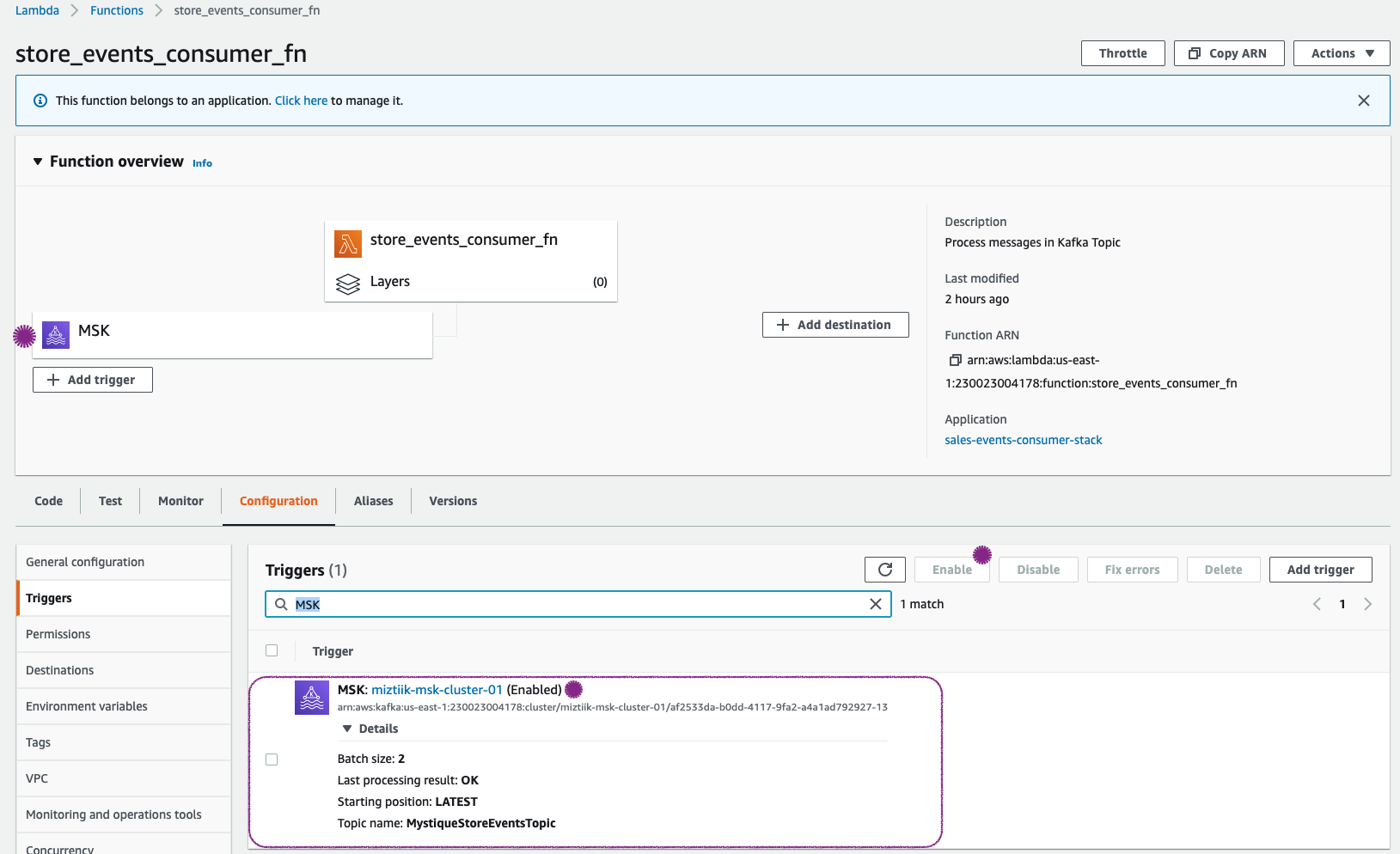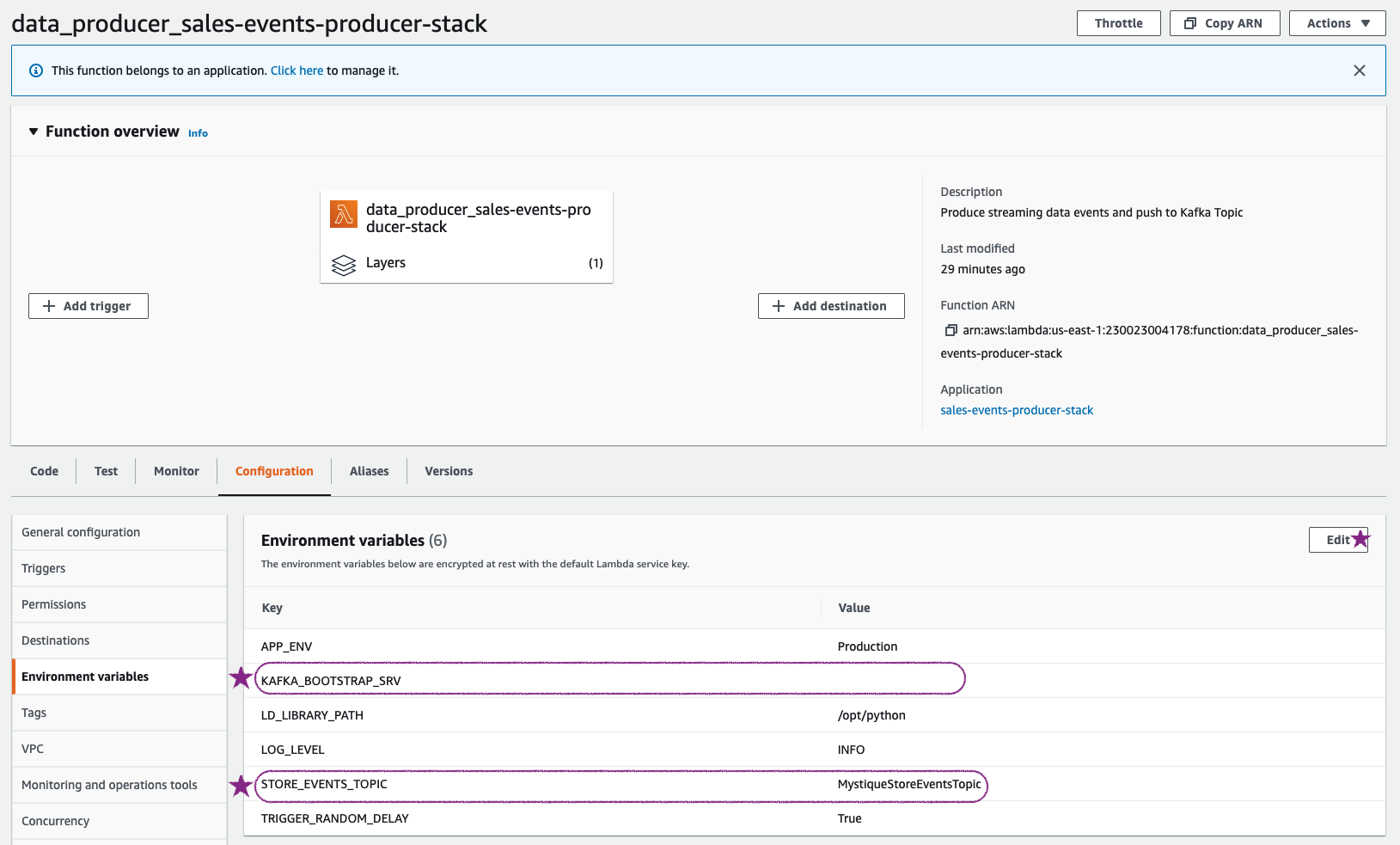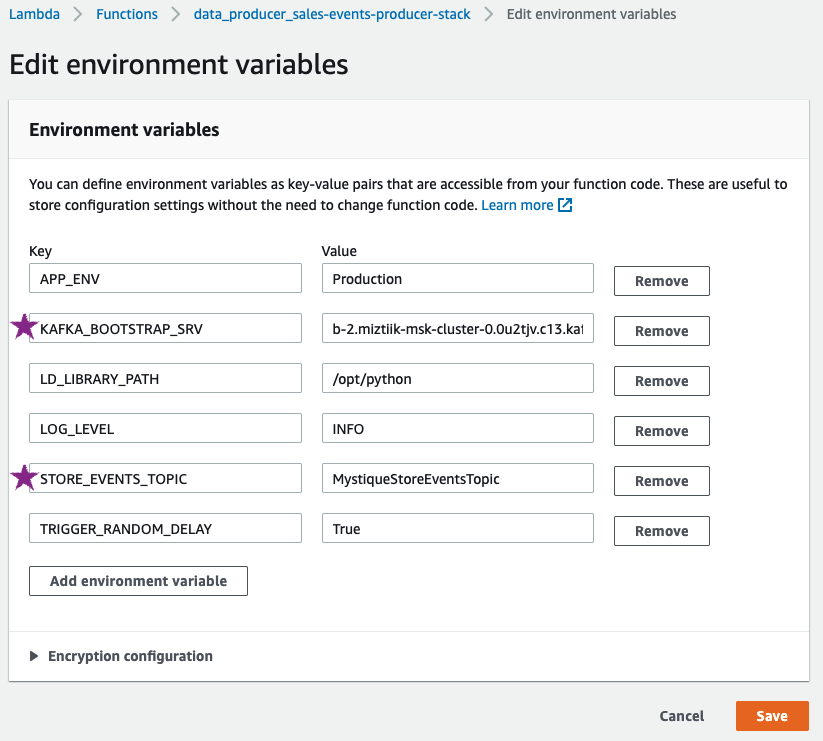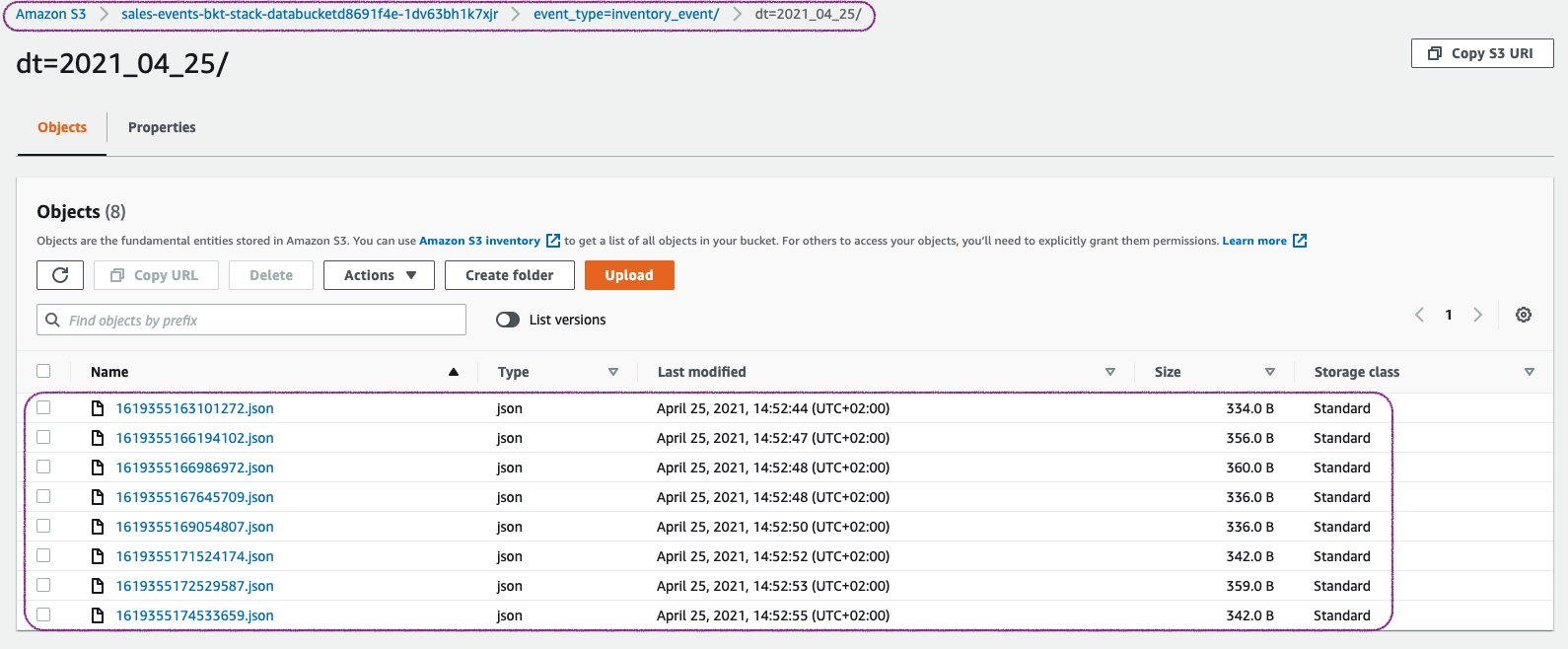The developer at Mystique Unicorn are interested in building their application using event-driven architectural pattern to process streaming data. For those who are unfamiliar, An event-driven architecture uses events to trigger and communicate between decoupled services and is common in modern applications built with microservices. An event is a change in state, or an update, like an item being placed in a shopping cart on an e-commerce website.
In this application, they will have their physical stores, send a stream sales and inventory related events to a central location, where multiple downstream systems will consume these events. For example, A event for a new order will be consumed by the warehouse system and the sales events will be used by the marketing department to generate revenue and forecast reports. This pattern of separating the produce, router and consumer to independent components allows them to scale the applications without constraints.
They heard that AWS offers capabilities to build event-driven architectures, Can you help them?
Amazon MSK1 is a fully managed service(for kafka) that makes it easy for you to build and run applications that use Apache Kafka to process streaming data. Apache Kafka is an open-source platform for building real-time streaming data pipelines and applications. With Amazon MSK, We can use native Apache Kafka APIs to populate data lakes, stream changes to and from databases, and power machine learning and analytics applications. The integration with AWS Lambda allows you to poll your Apache Kafka topic partitions for new records and invokes your Lambda function synchronously.
Let us consider a scenario, where a store is sending a stream of sales and inventory events that are to be consumed by two different personas. The sales managers and business analysts will need access to sales data to project revenue and create new marketing campaigns. The warehouse/delivery teams will need access to the inventory data to ensure the orders are dispatched to customer and restocked as needed. The event payload will look similar to this,
{
"request_id": "f5570d0f-5389-4bce-98c3-7ed5380eefb2",
"event_type": "inventory_event",
"store_id": 6,
"cust_id": 206,
"category": "Camera",
"sku": 100657,
"price": 2.52,
"qty": 18,
"discount": 8.2,
"gift_wrap": true,
"variant": "red",
"priority_shipping": true,
"ts": "2021-04-25T12:52:40.938937",
"contact_me": "github.com/miztiik"
}In this demo, we will create a the architecture like the one shown above. We will have a
- Kafka Cluster- Our primary events router with
2brokers for high availability- The cluster is named
miztiik-msk-cluster-01
- The cluster is named
- producer - Use a lambda function to creates sale events and ingests them to kafka topic
- consumer - A lambda function configured to be triggered by events in kafka topic and persist the events in S3
- Kafka Admin - An EC2 instance to administer the cluster - For ex. create kafka topics or modify topic attributes
- An Kafka Topic named
MystiqueStoreEventsTopic. Created using EC2 userdata script. The same is hard coded as environment variables for the producer & consumer lambda functions
- An Kafka Topic named
- Data Bucket - Persistent storage for the consumer
-
This demo, instructions, scripts and cloudformation template is designed to be run in
us-east-1. With few modifications you can try it out in other regions as well(Not covered here).- 🛠 AWS CLI Installed & Configured - Get help here
- 🛠 AWS CDK Installed & Configured - Get help here
- 🛠 Python Packages, Change the below commands to suit your OS, the following is written for amzn linux 2
- Python3 -
yum install -y python3 - Python Pip -
yum install -y python-pip - Virtualenv -
pip3 install virtualenv
- Python3 -
-
-
Get the application code
git clone https://github.com/miztiik/event-streams-with-managed-kafka cd event-streams-with-managed-kafka
-
-
We will use
cdkto make our deployments easier. Lets go ahead and install the necessary components.# You should have npm pre-installed # If you DONT have cdk installed npm install -g aws-cdk # Make sure you in root directory python3 -m venv .venv source .venv/bin/activate pip3 install -r requirements.txt
The very first time you deploy an AWS CDK app into an environment (account/region), you’ll need to install a
bootstrap stack, Otherwise just go ahead and deploy usingcdk deploy.cdk bootstrap cdk ls # Follow on screen promptsYou should see an output of the available stacks,
sales-events-bkt-stack event-streams-with-managed-kafka-vpc-stack sales-events-kafka-stack kafka-admin-on-ec2-stack sales-events-producer-stack sales-events-consumer-stack
-
Let us walk through each of the stacks,
-
Stack: sales-events-bkt-stack
This stack will create the s3 bucket. We will add a bucket policy to delegate all access management to be done by access points.
Initiate the deployment with the following command,
cdk deploy sales-events-bkt-stack
After successfully deploying the stack, Check the
Outputssection of the stack. You will find theSalesEventsBucket. -
Stack: sales-events-kafka-stack As we are starting out a new cluster, we will use most default and choose
2brokers for high availability. Each broker has about 1000GB of block storage attached to them. We need a VPC to host our kafka cluster, this dependency is resolved by using the vpc stackevent-streams-with-managed-kafka-vpc-stack. The brokers will be launched in the private subnet. At this moment we are not configuring any authentication or encryption of data in our cluster.Initiate the deployment with the following command,
cdk deploy event-streams-with-managed-kafka-vpc-stack cdk deploy sales-events-kafka-stack
After successfully deploying the stack, Check the
Outputssection of the stack. You will find theSalesEventsKafkaRoutercluster resource. -
Stack: kafka-admin-on-ec2-stack
To simulate the access of kafka admin, we use a simple ec2 instance that we can access. The EC2 instance will be launched in the public subnet along with a IAM Role that supports SSM Session Manager access2. This Ec2 instance IAM role also has permissions to interact only with the cluster
SalesEventsKafkaRoutercreated by the previous stack.Initiate the deployment with the following command,
cdk deploy event-streams-with-managed-kafka-vpc-stack cdk deploy sales-events-kafka-stack
After successfully deploying the stack, Check the
Outputssection of the stack. You will find the Kafka Admin instanceKafkaAdminInstancethat we will later use for creating/listing topics -
Stack: sales-events-producer-stack
This stack will create the producer lambda function will generate a payload(like the one shown above). We need the kafka client libraries to ingest the payload to the kafka topic. This has been packaged as a lambda layer along with the function. If you are interested take a look here
stacks/back_end/serverless_kafka_producer_stack/lambda_src/layer_code/. The name of the topic and the broker server information are passed as environment variables to the lambda function. The lambda is designed to run for10seconds that will generate approximately about 13 events per run.Initiate the deployment with the following command,
cdk deploy sales-events-producer-stack
After successfully deploying the stack, Check the
Outputssection of the stack. You will find theSaleOrderEventsProducerresource. -
Stack: sales-events-consumer-stack
This stack will create a lambda consumer function. The function will be configured will a MSK Event trigger3.
cdk deploy sales-events-consumer-stack
After successfully deploying the stack, Check the
Outputssection of the stack. You will find themsgConsumerresource.
-
-
-
Connect To Ec2 Consumer:
Connect the
KafkaAdminInstanceinstance using SSM Session Manager3. Navigate to/var/kafka/directory. Kafka has been preinstalled and if user-data script had ran successfully, we should have a kafka topic created automatically for us. You can check the user data script status in logs on the instance at/var/log/miztiik-automation-*.log. The same log had been pushed to cloudwatch as well.Let us verify the kafka topic exists
# Set the environment variables cd /var/kafka KAFKA_CLUSTER_NAME="miztiik-msk-cluster-01" STORE_EVENTS_TOPIC="MystiqueStoreEventsTopic" EC2_AVAIL_ZONE=`curl -s http://169.254.169.254/latest/meta-data/placement/availability-zone` AWS_REGION="`echo \"$EC2_AVAIL_ZONE\" | sed 's/[a-z]$//'`" KAFKA_CLUSTER_ARN=`aws kafka list-clusters --region ${AWS_REGION} --cluster-name-filter ${KAFKA_CLUSTER_NAME} --output text --query 'ClusterInfoList[*].ClusterArn'` KAFKA_ZOOKEEPER=`aws kafka describe-cluster --cluster-arn ${KAFKA_CLUSTER_ARN} --region ${AWS_REGION} --output text --query 'ClusterInfo.ZookeeperConnectString'` BOOTSTRAP_BROKER_SRV=`aws kafka get-bootstrap-brokers --region ${AWS_REGION} --cluster-arn ${KAFKA_CLUSTER_ARN} --output text --query 'BootstrapBrokerStringTls'` ./bin/kafka-topics.sh --list --zookeeper ${KAFKA_ZOOKEEPER} # Just incase, you want to create another topic, change the topic name and try this command ./bin/kafka-topics.sh --create --zookeeper ${KAFKA_ZOOKEEPER} --replication-factor 2 --partitions 2 --topic ${STORE_EVENTS_TOPIC}
If you try to create the same topic again, you will get an error,

At this point, we are almost set to use our kafka cluster.
-
Prepare Event Stream Consumer Lambda: The event stream consumer
msgConsumeris configured to be triggered by our kafka cluster. This is set up by cloudformation and sometime this trigger isdisabledif the kafka cluster topic is unavailable or the cluster it not ready. Let us ensure our trigger is inEnabledstate
In case the topic is unavailable before this trigger was created, you may see an error
Last processing result: **PROBLEM: Topic not found.**like this. Try to disable to and re-enable the trigger.If you have ensured the topic exists from
KafkaAdminInstanceand still the error persists, continue to the producer and invoke events. That should make the error go away. -
Invoke Sale Order Events Producer: Before invoking this function, let us ensure the environment variables for kafka topics and bootstrap server information is set correctly.

You can grab the bootstrap server information from the
KafkaAdminInstanceor from MSK Console > Clusters >miztiik-msk-cluster-01> View Client information > Bootstrap Servers
Let us invoke the lambda
SaleOrderEventsProducerfrom the AWS Console. This function is designed to create bothsales_eventandinventory_eventtype events. If you want more events, invoke the function few times. Upon successful invocation you should a result like this,{ "resp": { "status": true, "tot_msgs": 13, "bad_msgs": 0, "sale_evnts": 5, "inventory_evnts": 8, "tot_sales": 633.8199999999999 } } -
Check S3 Data Bucket for Event:
Navigate to
SalesEventsBucketin S3 Console, Here you can notice that the events are stored under two prefixessales_eventorinventory_event. As an example, here under theinventory_eventprefix you will find the files received by our consumer functionYou can use S3 select to view the files.
-
-
Here we have demonstrated how to use kafka to route events between producers and consumers. You can extend this by using kafka's capability filter messages based on attributes. For example, the producer in this case is designed to produce some bad messages. You can write a rule to filter out the
bad_msgsbefore sending them to consumers. -
If you want to destroy all the resources created by the stack, Execute the below command to delete the stack, or you can delete the stack from console as well
- Resources created during Deploying The Application
- Delete CloudWatch Lambda LogGroups
- Any other custom resources, you have created for this demo
# Delete from cdk cdk destroy # Follow any on-screen prompts # Delete the CF Stack, If you used cloudformation to deploy the stack. aws cloudformation delete-stack \ --stack-name "MiztiikAutomationStack" \ --region "${AWS_REGION}"
This is not an exhaustive list, please carry out other necessary steps as maybe applicable to your needs.
This repository aims to show how to use kafka as an event router to new developers, Solution Architects & Ops Engineers in AWS. Based on that knowledge these Udemy course #1, course #2 helps you build complete architecture in AWS.
Thank you for your interest in contributing to our project. Whether it is a bug report, new feature, correction, or additional documentation or solutions, we greatly value feedback and contributions from our community. Start here

- AWS Docs: Amazon MSK
- AWS SSM Session Manager
- AWS Docs: Amazon MSK cluster as an event source
- AWS Docs: Create Topics
- Docs: Troubleshooting Your Amazon MSK Cluster
Level: 200



